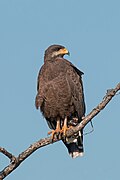Reconstruction:Proto-Turkic/seče
Appearance
Proto-Turkic
[edit]Etymology
[edit]Borrowed from Sogdian 𐼼𐼷𐼿𐼷 (sycy, “sparrow”). Compare also its diminutive 𐼼𐼷𐼿𐼰𐼸𐼸 (sycʾkk). Akin to Yagnobi сича (siča, “bird, sparrow”), сичак (sičak, “sparrow”).[1]
Clauson suggets a derivation from *seč- (“to choose”), however this is semantically unlikely.
According to Rasanen the Oghur form is an Oghuz borrowing. This would explain the intrusive -r- which is typical of Oghuz (cf. *sep- and *čap-) occuring in Oghur.
Noun
[edit]*seče
- (Oghuz Turkic) sparrow
Declension
[edit]Declension of *seče
| Singular 3) | |
|---|---|
| Nominative | *seče |
| Accusative | *sečeg, *sečeni1) |
| Genitive | *sečeniŋ |
| Dative | *sečeke |
| Locative | *sečede |
| Ablative | *sečeden |
| Allative | *sečegerü |
| Instrumental 2) | *sečen |
| Equative 2) | *sečeče |
| Similative 2) | *sečeleyü |
| Comitative 2) | *sečeligü |
1) Originally only in pronominal declension.
2) The original instrumental, equative, similative & comitative cases have fallen into disuse in many modern Turkic languages.
3) Plurality is disputed in Proto-Turkic. See also the notes on the Proto-Turkic/Locative-ablative case and plurality page in Wikibooks.
2) The original instrumental, equative, similative & comitative cases have fallen into disuse in many modern Turkic languages.
3) Plurality is disputed in Proto-Turkic. See also the notes on the Proto-Turkic/Locative-ablative case and plurality page in Wikibooks.
Descendants
[edit]Common Turkic:
See also
[edit]| Animals in Turkic | |||||
|---|---|---|---|---|---|
 |
dog: *ï̄t |
 |
hunting dog: *eker |
 |
hen: *tiakïgu |
 |
lark: *torgay |
 |
dove, pigeon: *kȫkerčin |
 |
quail: *bïldurčïn |
 |
sparrow: *serče |  |
hawk, falcon: *kïrguy |
 |
goose: *kāŕ |
 |
wolf: *bȫrü |
 |
cow: *ingek |
 |
calf: *buŕagu |
 |
camel: *tebe |
 |
young of camel: *kȫĺek, *botu |
 |
horse: *at |
 |
foal: *kulun |
 |
worm: *kūrt |
 |
snake: *yï̄lan |
 |
fox: *tilkü |  |
goat: *keči |  |
he-goat: *teke |
 |
lion: *arsïlan |
 |
fish: *bālïk | carp bream: *čapak | |
 |
donkey: *eĺčgek |  |
carp: *siāŕgan |  |
catfish: *yāyïn |
 |
beaver: *kunduŕ |  |
hedgehog: *kirpi |  |
badger: *borsmuk |
 |
fly, mosquito: *siŋek |  |
wasp, bee: *ārï |  |
gadfly: *bȫgen |
 |
moth: *küńe |  |
louse: *bït |  |
earthworm: *sïbuĺgan |
 |
yak: *kotuz |  |
colt: *sïp |  |
dragon: *siāŕgan |
 |
worm: *kūrt |  |
deer: *keyik, *sïgun, *bulan, *bugu |  |
lizard: *keleŕ |
References
[edit]- al-Kashgarî, Mahmud (1072–1074) Besim Atalay, transl., Divanü Lûgat-it-Türk Tercümesi [Translation of the “Compendium of the languages of the Turks”] (Türk Dil Kurumu Yayınları; 521) (in Turkish), 1985 edition, volume III, Ankara: Türk Tarih Kurmu Basımevi, published 1939–1943, page 219
- Clauson, Gerard (1972) “seçe:”, in An Etymological Dictionary of pre-thirteenth-century Turkish, Oxford: Clarendon Press, page 795
- Levitskaja, L. S., Blagova, G. F., Dybo, A. V., Nasilov, D. M., Pocelujevskij, Je. A. (2003) Etimologičeskij slovarʹ tjurkskix jazykov [Etymological Dictionary of Turkic Languages] (in Russian), volume VII, Moscow: Vostočnaja literatura, page 267
- Tenišev E. R., editor (1984–2006), Sravnitelʹno-istoričeskaja grammatika tjurkskix jazykov: [Comparative Historical Grammar of Turkic Languages:] (in Russian), Moscow: Nauka, page 177
- Räsänen, Martti (1969) Versuch eines etymologischen Wörterbuchs der Türksprachen (in German), Helsinki: Suomalais-ugrilainen seura, page 412
- Starostin, Sergei, Dybo, Anna, Mudrak, Oleg (2003) “*serče”, in Etymological dictionary of the Altaic languages (Handbuch der Orientalistik; VIII.8)[2], Leiden, New York, Köln: E.J. Brill
- Gharib, B. (1995) “sycy”, in Sogdian dictionary: Sogdian–Persian–English, Tehran: Farhangan Publications, page 368

